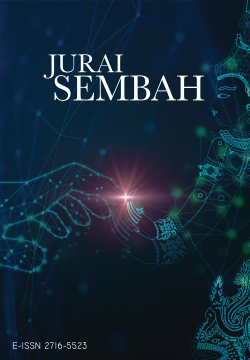The Transformation of Latar Tirai in Bangsawan Tengku Anum (2002) Istana Budaya
DOI:
https://doi.org/10.37134/juraisembah.vol4.1.4.2023Keywords:
bangsawan, bangsawan tengku anum, stage design, traditional malay theatre, transformationAbstract
Bangsawan is a theatre form that consists of acting, singing, music, dancing, and has a strong influence from Wayang Parsi from India. It was brought to Penang, Malaysia in the 1870s by the Indian workers who worked in Penang at that time. It experienced a period of fame in the 1890s and began its downfall in the early 1940s. The opening of Istana Budaya in 1999 gave opportunities for bangsawan to be revived in the twenty-first century, especially in dealing with modern stage technologies that were available. Bangsawan Tengku Anum, which is the third bangsawan, was staged in Istana Budaya from 18-22 December 2002, directed by Rosminah Tahir. This article examines the stage design of the bangsawan, mainly focusing on the usage of Latar Tirai. Bangsawan uses seven types of Latar Tirai that are used for each scene in this performance. Latar tirai is a backdrop hand painted on canvas representing the scene location and it is placed on stage as the stage background for each scene in bangsawan. It is painted on a canvas measuring 20’ feet wide and 15’ feet high, according to the suitability of the stage venue, and requires a high cost and is very time demanding. Bangsawan Tengku Anum transforms the use of hand painted Latar Tirai on canvas to paintings projected using a projector. It provides an innovation in traditional theatre performance. This paper discusses the transformation of Latar Tirai in Bangsawan Tengku Anum in adapting to the current modern stage technologies and in competing with the contemporary theatre today.
Downloads
References
A. Zaeny. (2005). Transformasi sosial dan gerakan Islam di Indonesia. Jurnal Pengembangan Masyarakat Islam, 2, 153-165.
Abdul Samad Salleh. (2006). Acting aspect in bangsawan theatre. National Department For Culture And Arts, Ministry of Culture, Arts and Heritage Malaysia (KEKKWA).
Armin Azhari Saleh. (2018). Seni dan budaya memerlukan transformasi. Dewan Budaya, 40(3).
Jamiaht Al Sheikhiah Shaikh Razak. (2015). Extra-turn dalam teater bangsawan di semenanjung Tanah Melayu di antara tahun 1900 hingga lewat tahun 1930 [Extra-turn in bangsawan theatre in the Malay Peninsula between 1900 and late 1930] (Unpublished master’s thesis). Universiti Sains Malaysia.
Jefri Haron. (2014). Estetika set tirai latar babak teater bangsawan koleksi Rahman B [Aesthetics of the curtain set of the bangsawan theatre scene collection of Rahman B] (Unpublished master’s thesis). Universiti Pendidikan Sultan Idris.
Mohamed Ghouse Nasuruddin (2009). Traditional Malay theatre. Dewan Bahasa dan Pustaka.
Nur Afifah Vanitha Abdullah. (2017). Peranan bangunan berpentas prosenium dalam tradisi persembahan bangsawan di Sarawak. Wacana Seni, 16, 85-102. https://ejournal.usm.my/wacanaseni/article/view/ws-vol16-2017-4
Pavelka, M. (2015). So, you want to be a theatre designer? Nick Hern Books.
Rahmah Bujang. (1975). Sejarah perkembangan drama bangsawan di Tanah Melayu dan Singapura. Dewan Bahasa dan Pustaka.
Rahmah Bujang. (1989). Seni persembahan bangsawan. Dewan Bahasa dan Pustaka.
Rahmah Bujang. (2016). Perkembangan drama bangsawan (Edisi kedua). Dewan Bahasa dan Pustaka.
Sabzali Musa Kahn. (2009). Reka bentuk dan binaan set. In Said Halim S. N. (ed.), Apresiasi seni teater malaysia. (p. 133-157). Pusat Kebudayaan Universiti Malaya.
Tan Sooi Beng. (1993). Bangsawan: A social and stylistic history of popular Malay opera. Oxford University Press.
Tan Sooi Beng. (2011). Bangsawan Malaysia staging cultural diversity & change. Nusantara Performing Arts Research Center.
Downloads
Published
How to Cite
Issue
Section
License
Copyright (c) 2023 MUHAMMAD ALHAKEEM HUSAIN, Norzizi Zulkafli

This work is licensed under a Creative Commons Attribution-NonCommercial-ShareAlike 4.0 International License.



